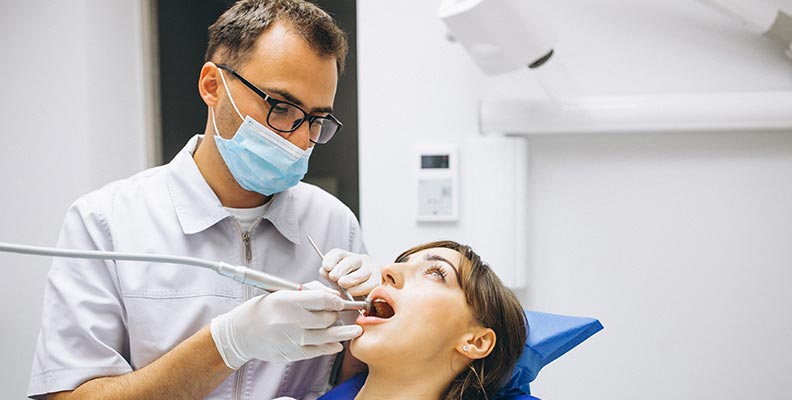Welcome to the Ultimate Guide to SEO for Dental Websites! In today’s digital age, having a strong online presence is crucial for any dental practice. With potential patients turning to search engines like Google to find local dentists, your website must appear at the top of the search results. That’s where SEO comes in.
Search Engine Optimization (SEO) is the process of improving your website’s visibility and ranking on search engine results pages. By implementing effective SEO strategies, you can attract more organic traffic to your Dental website marketing and ultimately grow your patient base.
In this comprehensive guide, we will walk you through everything you need to know about optimizing your website for better search engine rankings. From understanding the basics of SEO to creating a keyword strategy specific to dental practices, we’ve got you covered.
So whether you’re a seasoned dentist looking to enhance your online presence or a new practitioner wanting to make a splash in the digital world, buckle up and get ready as we dive into the exciting world of SEO for dental websites! Let’s boost your online presence together!

In today’s digital age, having a strong online presence is crucial for any business, including dental practices. One of the most effective ways to boost your online visibility and reach potential patients is through search engine optimization (SEO).
When people need dental services, they often turn to search engines like Google to find a local dentist. If your website doesn’t appear on the first page of search results, chances are those potential patients won’t even know you exist. This is where SEO comes in.
By implementing SEO strategies tailored specifically for Dental website marketing, you can improve your website’s ranking on search engine results pages (SERPs) and increase organic traffic to your site. This means more people will be able to find and visit your website when searching for dental services in their area.
Not only does SEO help drive more traffic to your website, but it also helps target the right audience – those who are actively looking for dental services. By optimizing your website with relevant keywords related to dentistry and specific treatments or procedures offered by your practice, you can attract highly qualified leads who have a higher chance of converting into actual patients.
Additionally, SEO allows you to establish credibility and trust among potential patients. When your website appears at the top of SERPs, it gives off the impression that you’re a reputable dentist with expertise in providing quality care. People generally trust Google’s rankings and are more likely to click on websites that appear at the top.
Moreover, investing in SEO can provide long-term benefits for your dental practice. Unlike paid advertising campaigns that require ongoing financial investment to maintain visibility, once you’ve optimized your website with effective SEO techniques, it will continue working for you 24/7 without additional costs.
Implementing proper SEO strategies tailored specifically for Dental website marketing is essential if you want to stay ahead of the competition and attract new patients online consistently. By improving your website’s visibility and attracting targeted traffic, you can grow your dental practice and establish a strong

In today’s digital age, having a strong online presence is crucial for any dental practice. And one of the most effective ways to boost your online visibility is through search engine optimization (SEO). But what exactly is SEO and how can it benefit your dental website?
Simply put, SEO encompasses a set of strategies and techniques that aim to improve your website’s visibility on search engines like Google. By optimizing various elements on your site, you can increase its chances of ranking higher in organic search results.
One fundamental aspect of SEO is keyword research. This involves identifying the specific words and phrases potential patients are likely to use when searching for dental services online. By incorporating these keywords strategically into your website’s content, you can attract more relevant traffic.
Another key element of SEO is optimizing on-page content and meta tags. This includes crafting compelling titles and meta descriptions that accurately describe each page’s content while also incorporating relevant keywords.
Additionally, local SEO plays a vital role in attracting patients within your geographical area. It involves optimizing your website with location-specific keywords and ensuring consistent contact information across directories such as Google My Business.
Social media platforms also provide an excellent opportunity for dental practices to enhance their online presence through SEO. Sharing informative and engaging content on social media not only helps drive traffic back to your website but also signals credibility to search engines.
Measuring the success of your dental website’s SEO efforts is crucial, which is where tools like Google Analytics come into play. By tracking metrics such as organic traffic, bounce rate, and conversion rates, you can gain valuable insights into how well your site performs in terms of attracting visitors and converting them into patients.
While understanding the basics of SEO is essential for boosting your dental practice’s online presence, it’s important to note that mastering this ever-evolving field takes time and expertise.
Investing in professional assistance from a reputable Dental Website Designer can help ensure that all aspects – from keyword research to on-page optimization – are addressed effectively.
By implementing these SEO strategies tailored specifically for Dental website marketing, you can attract more targeted traffic, increase your online visibility, and grow your dental practice.

Creating a keyword strategy for your dental website is crucial when it comes to boosting your online presence. By strategically selecting and optimizing keywords, you can increase your visibility in search engine results pages (SERPs) and attract more targeted traffic to your site.
The first step in creating a keyword strategy is conducting thorough research. Start by brainstorming relevant terms that potential patients may use when searching for dental services. Consider both general keywords, such as “dentist” or “dental clinic,” as well as specific ones like “cosmetic dentistry” or “orthodontic treatment.”
Next, utilize keyword research tools like Google Keyword Planner or SEMrush to identify the search volume and competition level of each keyword. Aim for a balance between high search volume and low competition to maximize your chances of ranking well.
Once you have identified your target keywords, it’s time to optimize your website accordingly. Incorporate these keywords naturally into your website’s content, including headings, page titles, meta descriptions, and image alt tags. However, avoid overstuffing with too many keywords, as this could be seen as spammy by search engines.
Regularly monitor the performance of your chosen keywords using analytics tools like Google Analytics. This will help you evaluate which terms are driving the most traffic and conversions so that you can refine and adjust your strategy accordingly.
Remember that SEO is an ongoing process. Stay up-to-date with industry trends and continuously adapt and optimize your keyword strategy to stay competitive in the ever-changing digital landscape!

Optimizing on-page content and meta tags is a crucial aspect of SEO for dental websites. By strategically incorporating relevant keywords into your website’s content, you can improve its visibility in search engine results pages (SERPs) and attract more organic traffic.
When it comes to on-page optimization, start by conducting thorough keyword research to identify the terms potential patients are searching for. Once you have a list of target keywords, integrate them naturally into your website’s pages. This includes optimizing headings, subheadings, and body text with relevant keywords that accurately represent your dental practice.
In addition to incorporating keywords within the actual content, meta tags play an essential role in SEO for dental websites. Meta tags are snippets of HTML code that provide information about a webpage to search engines. The two most important types of meta tags are the title tag and the meta description.
The title tag appears as the clickable headline in SERPs and should accurately describe the content on each page while including targeted keywords. Aim for concise titles that capture users’ attention and entice them to click through to your site.
Meta descriptions appear below the title tag in SERPs and provide a summary of what visitors can expect from a particular webpage. Make sure your meta descriptions are informative and compelling, and include relevant keywords without sounding spammy or unnatural.
By optimizing on-page content with strategic keyword placement and crafting compelling meta tags, you increase your chances of ranking higher in search engine results pages (SERPs) – ultimately driving more traffic to your dental website.

When it comes to dental practices, targeting a local audience is essential for driving traffic and attracting potential patients. This is where local SEO techniques come into play. By optimizing your dental website for local search, you can increase your online visibility and reach the right audience in your area.
Make sure that your website includes relevant keywords with location-specific terms. For instance, instead of just using “dentist” as a keyword, incorporate phrases like “dentist in [your city]” or “[your city] dental clinic.” This will help search engines understand the geographical relevance of your content.
Another effective strategy is creating location-specific landing pages on your website. These pages should contain information about the services you offer at each location if you have multiple offices or branches. Include details such as address, phone number, and working hours to make it easier for potential patients to find you.
In addition to on-page optimization, don’t forget about off-page strategies as well. Encourage satisfied patients to leave reviews on platforms like Google My Business or Yelp. Positive reviews not only boost credibility but also improve rankings in local search results.
Make sure that all contact information on your website and other online directories is accurate and consistent across different platforms. Consistency plays a key role in enhancing trustworthiness in the eyes of both users and search engines.
By implementing these local SEO techniques effectively, you can ensure that when someone searches for dental services in their area online – they find YOU!

Social media has become an integral part of our daily lives, and it can also play a significant role in boosting your dental website’s SEO. Leveraging social media platforms effectively can help increase brand visibility, drive traffic to your website, and improve your search engine rankings.
One way to leverage social media for SEO is by regularly sharing engaging and informative content related to dentistry. By creating valuable posts that educate and entertain your audience, you can attract more followers who are likely to share your content with their networks. This increased engagement signals to search engines that your website is relevant and trustworthy.
Another strategy is to optimize your social media profiles with keywords related to dental services or treatments you offer. This will make it easier for potential patients searching for those specific terms on social media platforms like Facebook or Instagram to find you.
Additionally, actively participating in online communities such as dental forums or groups allows you to build relationships with other professionals in the industry. Sharing insights, answering questions, and providing helpful advice not only positions you as an authority but also increases the likelihood of others linking back to your website – which is a key factor in improving search engine rankings.
Remember that consistency is key when leveraging social media for SEO. Regularly posting high-quality content and engaging with your followers will help establish credibility both online and offline. So don’t underestimate the power of social media – use it strategically alongside other SEO tactics for maximum impact on your dental practice’s online presence!
![]()
Measuring and tracking the success of your dental website is crucial to understanding how effective your SEO efforts are. This is where Google Analytics comes into play. By using this powerful tool, you can gain valuable insights into your website’s performance and make data-driven decisions to improve its visibility and reach.
One of the key metrics to track in Google Analytics is organic search traffic. This tells you how many visitors come to your site from search engines like Google or Bing. By monitoring this metric over time, you can see if there are any fluctuations or trends that may indicate changes in your SEO strategy.
Another important metric is the bounce rate. This measures the percentage of visitors who leave your site after viewing only one page. A high bounce rate could mean that visitors are not finding what they’re looking for or that there are issues with the user experience on your site.
Conversion rate is another metric worth paying attention to. It tells you how many visitors take a desired action on your site, such as booking an appointment or filling out a contact form. By analyzing this data, you can identify areas where improvements can be made to increase conversions.
In addition to these metrics, it’s also important to track keyword rankings, referral traffic from other websites, and engagement metrics like time spent on page and pages per session.
By regularly reviewing and analyzing these metrics in Google Analytics, you can gain valuable insights into the effectiveness of your SEO efforts and make informed decisions about optimizing your dental website for better online visibility and increased patient acquisition.

When it comes to optimizing your dental website for search engines, there are some common mistakes that you should avoid at all costs. These mistakes can hinder your online visibility and prevent potential patients from finding your practice.
One of the biggest mistakes is neglecting keyword research. Without proper keyword optimization, search engines won’t understand what your website is about, making it difficult for them to rank you appropriately. Take the time to conduct thorough keyword research and incorporate relevant keywords into your content.
Another mistake is overloading your website with irrelevant or low-quality content. Remember, quality trumps quantity when it comes to SEO. It’s important to provide valuable and informative content that addresses the concerns and questions of potential patients.
Ignoring on-page optimization is another common pitfall. Make sure you optimize each page of your website by including relevant meta tags, such as title tags and meta descriptions that accurately describe the page’s content.
Neglecting local SEO techniques is also a big mistake for dental practices. Local SEO helps improve your visibility in specific geographic areas where potential patients reside. Be sure to include location-specific keywords throughout your website and claim business listings on platforms like Google My Business.
Furthermore, failing to leverage social media for SEO purposes can be detrimental. Social signals play a role in search engine rankings, so make sure you have an active presence on social media platforms like Facebook, Instagram, Twitter, etc., sharing engaging content regularly.
Last but not least, overlooking the importance of measuring and tracking results using tools like Google Analytics can hinder progress in improving your dental website’s performance.
By analyzing key metrics such as organic traffic sources,top-performing pages, and bounce rates, you’ll gain valuable insights into what strategies are working best. In conclusion, by avoiding these common mistakes in dental website SEO, you’ll be well-equipped to boost your online presence attract new patients, and stay ahead of the competition

In today’s digital age, having a strong online presence is crucial for dental practices. And one of the most effective ways to boost your visibility and attract more patients is through SEO. By implementing the strategies outlined in this ultimate guide, you can optimize your dental website and improve its ranking on search engine results pages.
Remember to start by understanding the basics of SEO for Dental Websites and creating a keyword strategy that aligns with your target audience’s search intent. Then, focus on optimizing your on-page content and meta tags to make it easier for search engines to understand what your website is about.
Don’t forget about local SEO techniques, as they can help you target potential patients within specific geographical areas. Utilizing social media platforms can also enhance your online presence and drive traffic to your website.
It’s important to track and measure the success of your SEO for Dental Website efforts using tools like Google Analytics. This will allow you to make data-driven decisions and continuously refine your strategies for better results.
Be mindful of common mistakes that many dental practices make when it comes to SEO for Dental Websites. Avoiding these pitfalls will ensure that you’re maximizing the effectiveness of your efforts.
By implementing these tips and staying up-to-date with evolving SEO for Dental Websites’ best practices, you’ll be well-equipped to boost the online presence of your dental practice and attract new patients. So don’t wait any longer – start optimizing today!
Remember, if marketing isn’t something you feel comfortable taking care of yourself or simply do not have time for; hiring Dental Website Designers who specialize in providing comprehensive digital marketing solutions specifically designed for dentists may be worth considering!

Why Hiring an SEO Professional in Roseville CA Can Transform Your Business

How to Find the Best WordPress Expert in Roseville for Your Website

How Local SEO Services in Sacramento Can Boost Your Business’s Online Presence

Why You Need the Best Web Designers in Sacramento for Your Business

Enhance Your Online Presence with Custom Web Design in Roseville CA

Top Strategies in Digital Marketing for Chiropractors

5 Reasons Why You Should Hire a Roseville WordPress Web Designer for Your Business Website